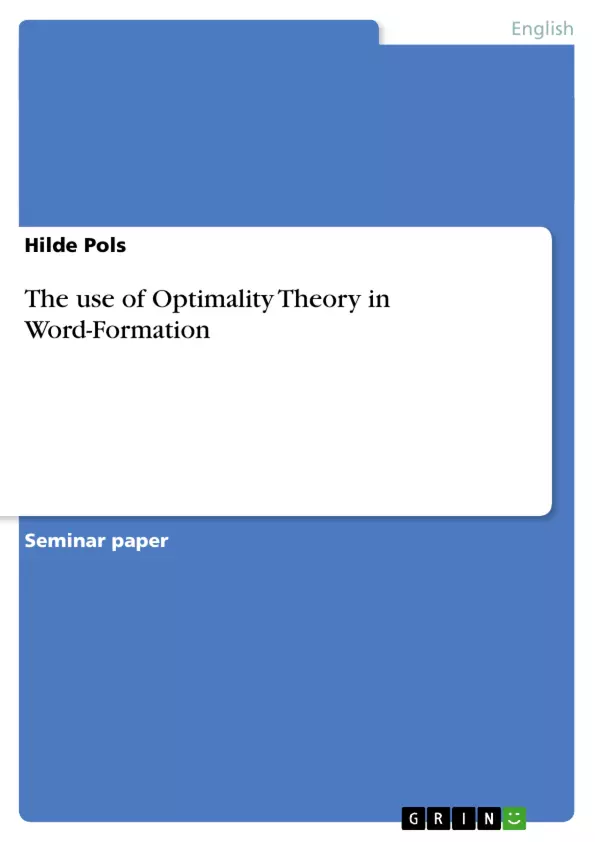The still rather young Optimality Theory (OT) has found its way into the linguistic discipline of word-formation triggering many new insights and new points of view. This has mainly taken place when analysing the creation of new words in the Englisch language on a morphological basis. This new point of view revealed new possibilities how the speakers decide on which form is right when coining a new word. But how far is this theory developed? Can we leave all formulated rules behind such as in the form of whenxattaches toythenzmust be applied?
This term paper will take a closer look at how OT is applied in derivations. After a historical and explanatory chapter on the theory itself two investigations by Ingo Plag ("The phonology of-izederivatives") and Renate Raffelsiefen ("Phonological constraints on English word formation") will be viewed to understand how the theory is applied. Finally the-itysuffixation will be observed on the basis of the results of the preceding two chapters.
To attain a textual flow for this thesis the individual constraints used by Plag and Raffelsiefen are summed up and explained in chapter six. Numbers in brackets refer to the page in their article where they have defined the constraint, whilst definitions in angle brackets represent a summary of how the author uses and understands it (only in cases when they did not formulate a definition). The reader may observe that a few constraints are listed under different names; this is dues to the fact that there does not seem to be a uniform naming scheme yet - therefore the constraints are named according to the authors use.
For the fourth chapter the Internet was a main reference to build up a corpus of-ityderived words. A search withOnelook®Dictionaryprovided a selection of 1068 tokens of different derivatives after sorting out phrases, loan words and those which have undegone even further derivation (i.e. Negation) from 8560. The choice to use this online dictionary search was made because the website searches through several types of dictionaries in the web, starting from the general ones to the more specialized ones (i.e. linguitical, or medical) as well as collections of neologisms (i.e.www.wordspy.com).
Inhaltsverzeichnis (Table of Contents)
- Introduction
- Optimality Theory
- Case studies
- "The phonology of -ize derivative": Ingo Plag
- "Phonological constraints on English word formation": Renate Raffelsiefen
- Applying OT to -ity suffixation
- Conclusion
- List of Constraints
- Bibliography
Zielsetzung und Themenschwerpunkte (Objectives and Key Themes)
This term paper aims to explore the application of Optimality Theory (OT) in word-formation, specifically within the context of English morphology. It examines how OT offers a new perspective on the process of creating new words, focusing on the speakers' choices in selecting the correct form. The paper investigates the development of this theory and its practical application in analyzing derivations.
- Application of Optimality Theory (OT) in word-formation
- Analyzing the process of creating new words in English
- Exploring the speakers' decision-making in choosing the correct word form
- Investigating the development and application of OT in analyzing derivations
- Examining the limitations and possibilities of OT in explaining word formation
Zusammenfassung der Kapitel (Chapter Summaries)
- Introduction: This chapter introduces the concept of Optimality Theory (OT) and its relevance to word-formation in English, highlighting the need for a new perspective on creating new words and the speaker's decision-making process. It also outlines the structure and scope of the paper.
- Optimality Theory: This chapter provides a detailed overview of Optimality Theory, its historical development, and its theoretical underpinnings. It explores the shortcomings of previous linguistic theories, such as generative phonology, and how OT addresses those limitations. It discusses the core principles of OT, including constraint ranking, the concept of harmony, and the role of violable constraints in selecting the optimal output.
- Case studies: This chapter examines two specific case studies: "The phonology of -ize derivatives" by Ingo Plag and "Phonological constraints on English word formation" by Renate Raffelsiefen. It analyzes how these studies apply OT to different aspects of word formation, illustrating the practical application of the theory.
- Applying OT to -ity suffixation: This chapter focuses on applying OT to the -ity suffixation, building on the findings from the previous chapters. It investigates the application of the constraint hierarchy and the selection of optimal forms in the context of -ity derivations.
Schlüsselwörter (Keywords)
The main keywords and focus topics of this paper include: Optimality Theory (OT), word formation, English morphology, constraints, constraint hierarchy, derivation, phonology, -ize derivatives, -ity suffixation, generative phonology, linguistic theory, and linguistic competence.
- Quote paper
- M. A. Hilde Pols (Author), 2005, The use of Optimality Theory in Word-Formation, Munich, GRIN Verlag, https://www.grin.com/document/53694



